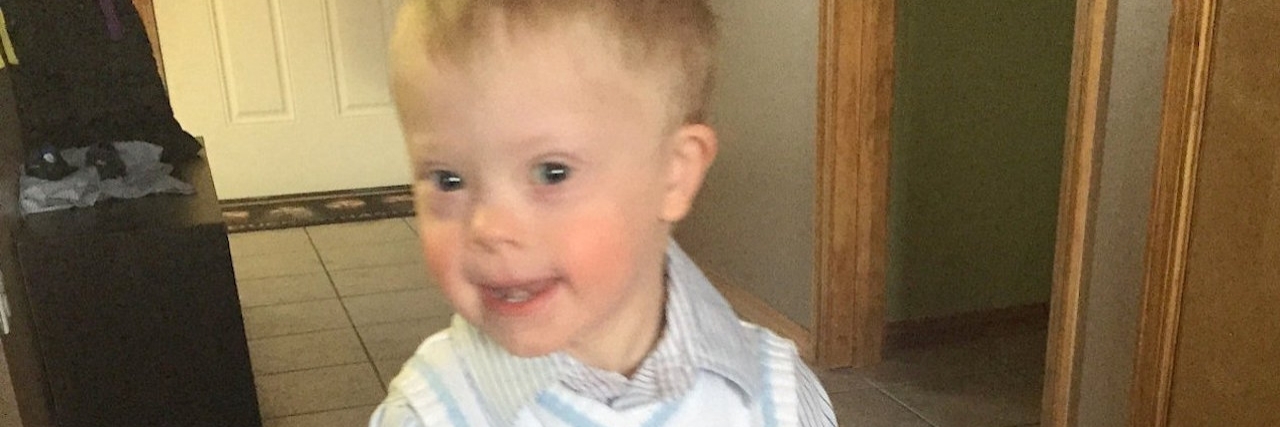My son, Gabe, got hurt. More specifically, he had a splinter. It was a fairly good-sized splinter, too. The outside crease of his hand was red and irritated. I wouldn’t have known it was there because it was cleverly hidden in the lines of his chubby little hand, but he told me about it. He told me about it. My sweet little boy came up to me, held up his little fist to show me and said, “Ow, tiss.”
I stared at him. My face was blank and my mouth was open. I apparently sat like that for a moment too long because he repeated the request, shoving his little fist even closer to my face. “Ow, tiss,” he said again. The insistence in his tone and his repeated request snapped me out of my amazed stupor. I took him over to the couch, flipped on the light and removed the splinter using my master splinter removing tool (tweezers). I gave it another kiss, he murmured “kyoo” — his version of thank you — and ran off to play with his “scoobus.”
I stared at him for a long time. I didn’t realize I was crying until I felt a tear drop onto my arm. I know what you’re thinking: “No big deal, he had a boo-boo. Mommy kissed it. All better, so what?” But it is a big deal. It’s a really freaking enormous deal! It’s not just a request from an injured toddler. This is an entire new world of realization and understanding we’re talking about. Gabe recognized he had an injury, he knew Mommy could fix it, how Mommy could fix it and then he told me about it. He didn’t just speak, he used language!
Speech and language are two different things. Speech is the physical production of sound. Gabe can speak. He repeats words that are spoken to him in the best way he can. He uses approximations of words. For example, dog is “dah,” thank you is “kyoo,” see you is “syou.” He also uses signs to speak along with his word approximations. He’ll say “mil” and sign milk. He’ll sign grandma and say “mama.”
Language is a method of human communication. It’s a rule-based set of processes. Language represents much more than just words. It represents thoughts and ideas. Language is social, it’s communicative, it’s a skill and it can be difficult.
Think about it like this: You see a cat. You think of the word “cat” in your mind and you want to say cat. So your brain puts the word “cat” in a car (motor impulse) and sends it down the highway (neurons) to your mouth (oral motor system). Your lungs have to fill up to produce the air to flow through the vocal cords to produce the sound that will turn into cat. The back of your tongue moves to the roof of your mouth in anticipation of the “c” sound. Your lips widen and your tongue drops down away from the roof of your mouth for the “aaa” sound. And then the tip of your tongue presses against the roof of your mouth, just behind your front teeth, to produce the “tuh” sound.
Now imagine the same process but it’s a bicycle instead of a car on a clogged-up highway. You have a mouth with muscles that aren’t as strong, feeling that isn’t as sensitive and two words to speak! It doesn’t sound like such an easy process now, does it? Speech is really hard! Language is even harder!
That’s why this is such a big deal. Gabe recognized his hand hurt and was able to name that feeling. He was able to problem solve. Who will make this feel better? Mommy! He was able to put a name to his feeling and establish a request in two seemingly simple words: “Ow, tiss.” He used language to express his pain and his desire for me to help him. It was beautiful. It was heartwarming. It made me want to jump up and down. And it made me cry.
I have cried a lot in the four years since we received Gabe’s Down syndrome diagnosis. It should be noted I’m kind of an emotional person anyway. In the beginning, I had mostly sad tears, but those disappeared the moment I held my sweet boy for the first time. I still have rare moments when I look too far into the future and begin to shed some worry-filled tears, but those are few and far between.
The tears that fall now are mostly ones of joy, happiness and laughter. Or when I step on one of the kids’ toys in my bare feet! Now I guess when I step on a toy, instead of crying, I can just look at Gabe, hold out my foot and say “Ow, tiss.”
This post originally appeared on Hand Me Downs.
Imagine someone Googling how to help you cope with your (or a loved one’s) diagnosis. Write the article you’d want them to find. If you’d like to participate, please check out our Submit a Story page for more about our submission guidelines.
Have you seen the first film with a national release to star a person with Down syndrome? Check out the film “Where Hope Grows” today!

